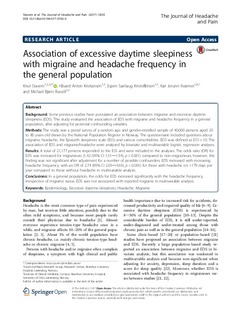Association of excessive daytime sleepiness with migraine and headache frequency in the general population
Stavem, Knut; Kristiansen, Håvard; Kristoffersen, Espen Saxhaug; Kværner, Kari Jorunn; Russell, Michael Bjørn
Journal article, Peer reviewed
Published version
Permanent lenke
http://hdl.handle.net/11250/2489448Utgivelsesdato
2017Metadata
Vis full innførselSamlinger
- Publikasjoner fra CRIStin - BI [1015]
- Scientific articles [2181]
Sammendrag
Background: Some previous studies have postulated an association between migraine and excessive daytime sleepiness (EDS). This study evaluated the association of EDS with migraine and headache frequency in a general population, after adjusting for potential confounding variables.
Methods: The study was a postal survey of a random age and gender-stratified sample of 40,000 persons aged 20 to 80 years old drawn by the National Population Register in Norway. The questionnaire included questions about migraine, headache, the Epworth sleepiness scale (ESS) and various comorbidities. EDS was defined as ESS > 10. The association of EDS and migraine/headache were analysed by bivariate and multivariable logistic regression analyses.
Results: A total of 21,177 persons responded to the ESS and were included in the analyses. The odds ratio (OR) for EDS was increased for migraineurs (1.42 (95% CI 1.31─1.54), p < 0.001) compared to non-migraineurs; however, this finding was not significant after adjustment for a number of possible confounders. EDS increased with increasing headache frequency, with an OR of 2.74 (95% CI 2.05─3.65), p < 0.001) for those with headache on >179 days per year compared to those without headache in multivariable analysis.
Conclusions: In a general population, the odds for EDS increased significantly with the headache frequency, irrespective of migraine status. EDS was not associated with reported migraine in multivariable analysis.
Beskrivelse
This is an Open Access journal from Springer
